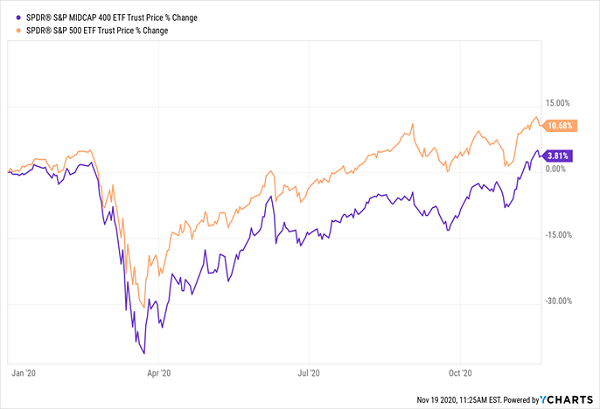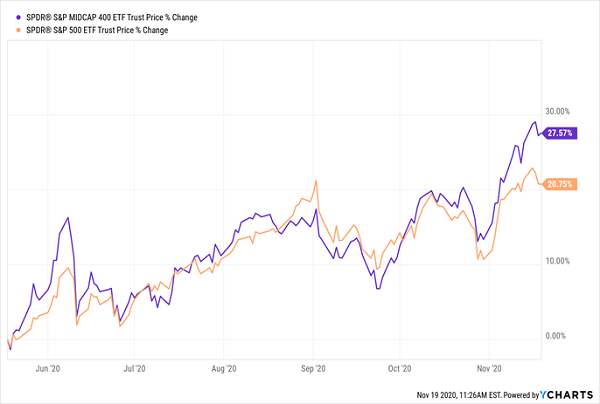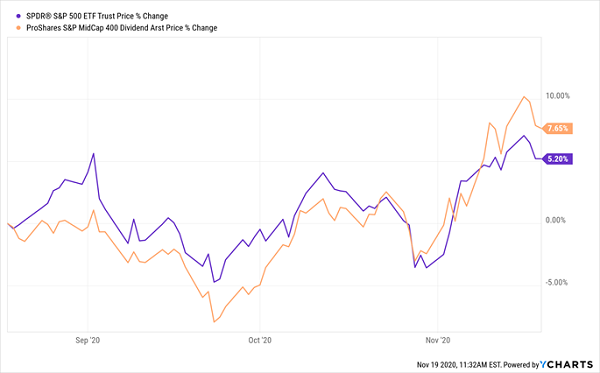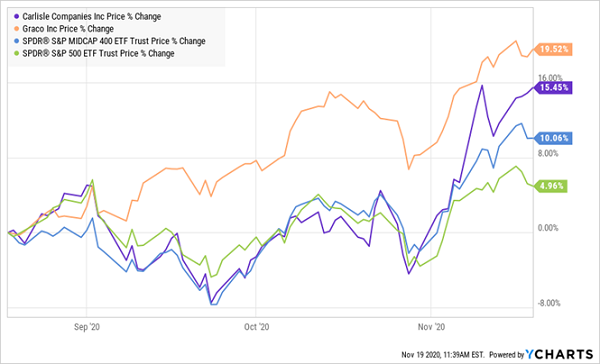One of the most powerful stock-market indicators you’ll ever find is a simple one I call “relative strength.”
It means that stocks that outperform now will likely keep outperforming. And if you catch them just as they start their next leg up, you’ll line yourself up for big gains (and dividends!).
I’ve found relative strength to be a potent strategy when it comes to timing the purchases of dividend stocks. With many income investors fishing in the same pond for payouts, identifying yield plays before the herd turns their attention to a particular sector often results in extra profits.
Mid-Cap Stocks: The Perfect Buys for 2021
We’ve got a nice “relative strength” play setting up in mid-cap stocks (those with market caps between $2 billion and $10 billion). I expect mid-caps to crush the S&P 500 in 2021—a year that’s already setting up to be the opposite of 2020, with two (and likely more) vaccines on the way and a settled presidential election delivering a level of certainty we haven’t seen in a long time.
Here’s why I’m bullish on mid-caps: if you look at the performance of the benchmark SPDR S&P 400 MidCap ETF Trust (MDY), you might conclude that mid-caps are losers: MDY lags the S&P 500 this year—by quite a lot:
Mid-Caps Trail the Big Names in 2020 …

But look at the end of that chart—you can see mid-caps’ “relative strength” kicking in—they’ve crushed the big names in just about every shorter timeframe you can think of: five days, one month, three months, six months. It isn’t even close!
… But They’re Just Starting to Accelerate

That makes now a great time to add to your portfolio’s mid-cap holdings. Here are three stocks that could be a great fit for you now:
A Mid-Cap ETF Pick That Grows Its Payout
Because midcaps can be tough for individual investors to get good info on, buying through an exchange-traded fund (ETF) can make sense. A good option is the ProShares S&P MidCap 400 Dividend Aristocrats ETF (REGL).
The fund, like all ETFs, is run by an algorithm, which is one reason why I prefer to buy through closed end funds (CEFs) or to pick up mid-caps individually. But if you’re going the ETF route, REGL has some key advantages: for one, it yields 2.2%, nearly double MDY’s 1.2% yield and well above the S&P 500 average of 1.6%.
You’re also assured of dividend growth: as REGL’s name implies, it follows the mid-cap “dividend aristocrats.” This group is different than the large cap Dividend Aristocrats you likely know. For one, the mid-cap versions have raised their payouts for 15 straight years, as opposed to 25 for the big names (this makes sense, as mid-caps tend to be younger than blue chips).
The upshot is that this focus on dividend growers—and dividend payers—results in a more stable fund than MDY, or even an S&P 500 index fund: REGL’s five-year “beta” rating is 0.87, making it 13% less volatile than the S&P 500.
That’s very rare among ETFs that focus on smaller stocks. And you’re not trading performance to get that stability: REGL is also showing relative strength versus the S&P 500, especially since the summer:
REGL’s “Hat Trick”: Stability, Big Payouts and Gains

All of this makes REGL a strong choice among ETFs. But don’t buy in just yet, because we can do a lot better if we buy our mid-caps “direct.”
2 Mid-Caps That Are Better Buys Than ETFs, Grow Payouts 150%+
Even though REGL isn’t my favorite option for mid-cap buying, we shouldn’t toss it out. Instead, let’s cherry-pick its portfolio for strong dividend payers. Two leap out:

Before we go further, let’s address the one thing that’s likely screaming at you from the chart above right now: both stocks’ low current yields.
Don’t let that put you off, because the two columns after the dividend yield tell the real story: both stocks’ dividends are way below my “safety line” of 50% of free cash flow (FCF). So they could goose their payouts by a lot—Carlisle Companies (CSL), in fact, could double its dividend tomorrow and the payout would still be safe!
Second, both have incredible dividend-growth records that will help you build up your yield on cost fast. If you’d bought Graco Inc. (GGG) a decade ago, you’d be yielding 5.8% on your buy today, nearly four times the stock’s current yield.
Carlisle? Because it’s more than tripled its payout in that time, you’d be looking at a 5.6% payout—almost six times what the stock pays today.
And how’s this for relative strength? Carlisle (in purple below) and Graco (in orange) have crushed MDY, in blue, and the SPDR S&P 500 ETF (SPY), in green, in the last three months. That’s a strong sign that now is a good time to buy:
Industrial Stars Get a Jump on 2021

These companies’ strong runs are likely just beginning, demand for their products—Graco provides gear for spraying coatings, paint and lubricants, while Carlisle sells engineered components to the construction, aerospace and automotive industries, among others—will likely pick up as more stimulus spending (a certainty—both parties have much to gain from sending out more checks to citizens) and vaccines give companies the certainty they need to unleash the record $1.9 trillion of cash they’re hoarding.
No wonder analysts have called for big earnings-per-share gains for both Graco and Carlisle (13% and 30%, respectively) in 2021. Now is a good time to buy as rising profits build on both companies’ relative strength—and push their shares higher.
Here’s an “Automatic” 10% Cash Return for 2021 (Paid Monthly!)
What if I told you that you could lock in an “automatic” 10% return in 2021? And you’d get that 10% win in cash, not paper gains?
I’m guessing you’d be interested. Who wouldn’t take a guaranteed 10% in cash after the year we’ve had?
Well, 10% in cash, year in and year out, is exactly what you get in my powerful “10% Monthly Dividend Portfolio.” Just like the name says, this carefully assembled collection of stocks and funds delivers a safe 10% average yield. PLUS, you get paid every single month, too.
10% Dividends, 10% Gains—in 1 Year (or Less)
And of course, that 10% just accounts for this new portfolio’s dividend, so it’s just the start of what you’re getting here. These stocks and funds are also terrific bargains (perhaps the last true bargains on the market!) now. That’s got them nicely primed for 10% price upside in the coming year, too.
So you’re looking at $10,000 in dividends and $10,000 in price gains on a $100K investment here—in just 12 months!
Think of how you could use an extra $20,000 next year. Reinvest it, buy that second home you’ve been considering … or maybe go an extended trip, once travel restrictions are lifted, something we’ll very likely see in 2021.
No matter how you choose to spend your dividends (and upside), you could have this cash at the ready when the gloom lifts and the economy returns to normal.
